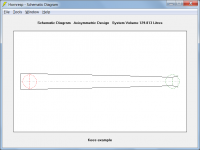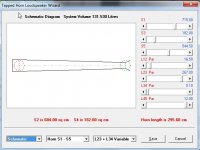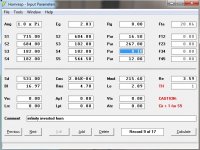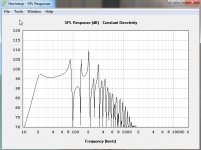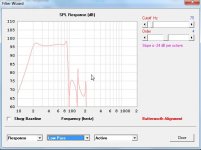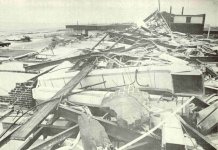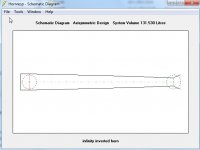Hi Kees,
It was 43.1 degrees Celsius here yesterday - heatwave conditions 🙂.
Don't use the Uni width flare setting if you want parallel sides - see the following post:
http://www.diyaudio.com/forums/subwoofers/119854-hornresp-403.html#post3765069
For the purposes of the simulation, assume that the final vertical opening as shown in your SketchUp drawing is the horn mouth S4. This means that S4 will be larger than 182 sq cm and that the axial path length L34 from S3 to S4 will curve through 90 degrees, and be considerably longer than 0.1 cm.
Your simulation schematic should look more like the one shown in the attached example screenprint.
Kind regards,
David
I hope it is not so cold there,
It was 43.1 degrees Celsius here yesterday - heatwave conditions 🙂.
I have again strange outcomes, and I do not now excactly why, there also so much digits after the comma (0.1mm)
see in txt file the width who needs to be 16.50 cm but change over in S2 to S3 and go again to 16.50 cm in S4, it needs 16.50 all over the length, it did not, with con flare the width is oke whole length 16.50 cm x 2 see con-uni-test.zip..
Don't use the Uni width flare setting if you want parallel sides - see the following post:
http://www.diyaudio.com/forums/subwoofers/119854-hornresp-403.html#post3765069
Another question is, when S4 is very short and end in the middle of the speaker do i need to measure there for calculated surface? (see picture.) opening in the half of the speaker I did measure as 182 square cm, the bigger opening of the rest I see as just opening for speaker other half who is outside the horn like on hornresp schematic.
For the purposes of the simulation, assume that the final vertical opening as shown in your SketchUp drawing is the horn mouth S4. This means that S4 will be larger than 182 sq cm and that the axial path length L34 from S3 to S4 will curve through 90 degrees, and be considerably longer than 0.1 cm.
Your simulation schematic should look more like the one shown in the attached example screenprint.
Kind regards,
David
Attachments
Is it the math behind using a Q function to describe the slopes of the filters?
Because that is very applicable for the other filter calculations as well. Different filter Q's can make quite a difference in the overall response shape. The smaller the number the sharper the roll off and vice versa.
Hi Mark,
The current filter functionality is as far as I am prepared to go. As previously stated, my main interest lies with horn loudspeaker theory and I have already spent far more time working on the Filter Wizard than I originally planned. Sorry, but the introduction of Quality factors at this late stage is not something that I would seriously consider. For more advanced signal processing and equalisation, you will need to use something other than Hornresp 🙂.
Kind regards,
David
Hi AndrewT,
L34 is the axial path length from the geometric centre (centroid) of the driver diaphragm to the geometric centre of the S4 opening. The diaphragm is assumed to be a plane circular piston, so L34 should begin near the front face of the cone where it attaches to the suspension surround, rather than down at the dust cap.
Provided that the actual constructed speaker matches the simulation model, predictions can be reasonably accurate - see following example.
The Subwoofer DIY Page v1.1 - Projects : "Proof of Concept #3"
Kind regards,
David
Where does one measure L3?
from the centroid of the moving cone?
from the centroid of the front face of the driver chassis?
from the diameter where the cone meets the dome?
to the centroid of the opening S4?
to the nearest edge of S4?
to the centroid of the volume between S4 and S3?
L34 is the axial path length from the geometric centre (centroid) of the driver diaphragm to the geometric centre of the S4 opening. The diaphragm is assumed to be a plane circular piston, so L34 should begin near the front face of the cone where it attaches to the suspension surround, rather than down at the dust cap.
What are the results of testing showing compared to the data input for Hornresp?
Provided that the actual constructed speaker matches the simulation model, predictions can be reasonably accurate - see following example.
The Subwoofer DIY Page v1.1 - Projects : "Proof of Concept #3"
Kind regards,
David
Hi Kees,
It was 43.1 degrees Celsius here yesterday - heatwave conditions 🙂.
Don't use the Uni width flare setting if you want parallel sides - see the following post:
http://www.diyaudio.com/forums/subwoofers/119854-hornresp-403.html#post3765069
For the purposes of the simulation, assume that the final vertical opening as shown in your SketchUp drawing is the horn mouth S4. This means that S4 will be larger than 182 sq cm and that the axial path length L34 from S3 to S4 will curve through 90 degrees, and be considerably longer than 0.1 cm.
Your simulation schematic should look more like the one shown in the attached example screenprint.
Kind regards,
David
Wauw 43 degrees. euhh no that is also to extreme, here it is now 9 degrees and sun, very nice work or walk weather.
Much people here say use uni export for tapped horns with same width boxes, also for T-TQWT, others say different things. I do now when using conical I get good numbers with export same width, but what I have to do precisely I have afcourse believe the program writer because he is the master and professor here.
The last example you did give, I have tryed already and it give no change in respons except it is more efficienty, I have S4 coupled to center of speaker, I think I go build this one for test, it is promising respons to 20 Hz and it is small.. I have now use this as you did offer in your last post, as on picture you can see the hornresp output as this is how the box is drawn, looks nice now om hornresp only I get error, see picture.
After this test tapped horn is next, with a wideband little horn from 70 Hz to 20 Khz.
How easy can I fool hornresp giving good respons but not in reality>? is this possible, nice question is'n it.
Thanks for your respond and enjoy warm weather, or not? hot hot, where do you live? america has a little ice-age..
regards.
Attachments
Last edited:
Response with a 24 dB oct low pass filter, this box want active amp, not a problem I get a very nice all-fet amp single ended drivers. I do not now however is there a need for stereo subwoofers? everything above 100 hz is mono? still? after introduction of digital superaudio, I think to go stereo so deepness and hall effect is present.
Attachments
David
I have a problem with latest version. Through loudspeaker wizard I have been able to enter invalid data into a record. Hornresp will not allow me to open the record.
I cannot PM you to share my hornresp file, maybe you can PM me?
Regards
Mårten
I have a problem with latest version. Through loudspeaker wizard I have been able to enter invalid data into a record. Hornresp will not allow me to open the record.
An externally hosted image should be here but it was not working when we last tested it.
I cannot PM you to share my hornresp file, maybe you can PM me?
Regards
Mårten
Australia
Hi mate.
Beautifull Country, beautifull software.
I had a friend who did not like Australia, to much poison. did not like the poison anymals there.
regards.
Attachments
I cannot PM you to share my hornresp file, maybe you can PM me?
Hi Mårten,
Just click on my name at the bottom of the Hornresp website to send me an email.
The website address is shown below.
I would be very interested to find the cause of the problem - thanks.
Kind regards,
David
G'day cobber 🙂.
It is offtopic but the heat and cold in the world are a problem these days, jetstreams do change, giving more heat waves and cold waves of short term, here ik holland we have the mildest winter ever with a lot of storms, so around 10 and sometimes 15 degrees, if this happens in summer we had a long term heatwave because of already 3 months of south winds from out Afrika, I have not yet seen elephants flying by... In link you see how agressive thunderstorms can get here where I live.
http://youtu.be/DLQGEIKI_h8
I had plans to go live there, but I can not get permit, to old maybe a finding a good wife there, and make amps and such in a beautifull country.
And now back to your software bugs finding, I go test if export to conical give good outcomes in sketchup, with export of exponential flare I get round effect witch wil not usable I need straight panel flare like tapped horn or transmission line.
regards
kees
Last edited:
Hi Kees,
That's just mild weather compared to what we can be subjected to 🙂.
In December 1975 I was temporarily working south of Port Hedland, Western Australia when Tropical Cyclone Joan struck. The attached photo shows what was left of the Port Hedland hospital after the cyclone passed through. The maximum estimated wind gust was 260 km/h. The hire car I had at the time had all the paint sand-blasted off its left hand side - back to bare metal. It was an experience that I will never forget, for as long as I live. The wind noise was unbelievable.
It seems that everything is working as it should.
Kind regards,
David
In link you see how agressive thunderstorms can get here where I live.
That's just mild weather compared to what we can be subjected to 🙂.
In December 1975 I was temporarily working south of Port Hedland, Western Australia when Tropical Cyclone Joan struck. The attached photo shows what was left of the Port Hedland hospital after the cyclone passed through. The maximum estimated wind gust was 260 km/h. The hire car I had at the time had all the paint sand-blasted off its left hand side - back to bare metal. It was an experience that I will never forget, for as long as I live. The wind noise was unbelievable.
And now back to your software bugs finding, I go test if export to conical give good outcomes in sketchup, with export of exponential flare I get round effect witch wil not usable I need straight panel flare like tapped horn or transmission line.
It seems that everything is working as it should.
Kind regards,
David
Attachments
Hi David
Yes beause the heat and warm water around Australia storms can be severe, one thing is nice, when you want to paint your car and get rid of rust just put them in a cyclone.
Here the biggest storm we had was a hurricane going 160 km hour wind gust, but I alwats say, when never nothing happening then living is so boring, from one point it is bad a hospital is blowing to peaces on the other hand it is impressive to experience such weather, in amerika the tornados are even more worse going sometimes 500 km hour wind, not gust but continu that fast.
here is mild weather indeed, but to much rain but 40 + like your place is also not so pleasant, look to the Australian open where sportman has stop until it cools down.
I have the test the flare, notdone yet, to busy and I have to go to dentist.
I let now.
regards
Yes beause the heat and warm water around Australia storms can be severe, one thing is nice, when you want to paint your car and get rid of rust just put them in a cyclone.
Here the biggest storm we had was a hurricane going 160 km hour wind gust, but I alwats say, when never nothing happening then living is so boring, from one point it is bad a hospital is blowing to peaces on the other hand it is impressive to experience such weather, in amerika the tornados are even more worse going sometimes 500 km hour wind, not gust but continu that fast.
here is mild weather indeed, but to much rain but 40 + like your place is also not so pleasant, look to the Australian open where sportman has stop until it cools down.
I have the test the flare, notdone yet, to busy and I have to go to dentist.
I let now.
regards
The heaviest rain I had ever experienced in my life up to now was in Australia. It felt like the car was under Niagara Falls, could not even see the road right in from of the car.
The heaviest rain I had ever experienced in my life up to now was in Australia. It felt like the car was under Niagara Falls, could not even see the road right in from of the car.
"I love a sunburnt country,
A land of sweeping plains,
Of ragged mountain ranges,
Of droughts and flooding rains."
~ Dorothea Mackellar ~
Hornresp Update 3330-140117
Hi Everyone,
The problem referred to in Post #4067 has now been fixed.
It was inadvertently introduced during the recent major changes to the Loudspeaker Wizard.
My thanks to Mårten ('more10') for reporting the bug.
Kind regards,
David
Hi Everyone,
The problem referred to in Post #4067 has now been fixed.
It was inadvertently introduced during the recent major changes to the Loudspeaker Wizard.
My thanks to Mårten ('more10') for reporting the bug.
Kind regards,
David
Hi David
The bug is gone 🙂
I have started to play with airflow resistivity. I made a simulation of a TL successfully dampening the first third of the cabinet. However, simulating a MLTL cannot be done since there are not enough sections :-(. I need just one more section to do it.
I use one 0,1 cm section to go from cabinet to port size. If it was allowed to start a new section with a new area, four sections would suffice.
Also I don't understand why direct radiation falls off above 200 Hz:
It should start falling at 400:
The bug is gone 🙂
I have started to play with airflow resistivity. I made a simulation of a TL successfully dampening the first third of the cabinet. However, simulating a MLTL cannot be done since there are not enough sections :-(. I need just one more section to do it.
I use one 0,1 cm section to go from cabinet to port size. If it was allowed to start a new section with a new area, four sections would suffice.
An externally hosted image should be here but it was not working when we last tested it.
Also I don't understand why direct radiation falls off above 200 Hz:
An externally hosted image should be here but it was not working when we last tested it.
It should start falling at 400:
An externally hosted image should be here but it was not working when we last tested it.
Hi All
For rain, jou need holland, but for gush away rain you need tropical, but sometimes in summer here can it go very violent as nordsea is still cold from winter, but hurricanes are rare here, and if one, it do damage very well.
Oke, done with wether, I have make a test for the flares, maybe David can do something with it, it looks so strange, I think when straight panels we need set loudspeaker wizzart to automatic S1,S2,S3,S4,S5.
I did drawn in sketchup, numbers in drawn are from straigt line from S1, to S4, S5 is not used here but are in export, it is one hole for output.
I have in zip the exports con, uni, and exp.
I do like when I did something wrong like not automatic flare in wizzard.
be carefull zip get not wet, with al that rain there.
regards
kees
For rain, jou need holland, but for gush away rain you need tropical, but sometimes in summer here can it go very violent as nordsea is still cold from winter, but hurricanes are rare here, and if one, it do damage very well.
Oke, done with wether, I have make a test for the flares, maybe David can do something with it, it looks so strange, I think when straight panels we need set loudspeaker wizzart to automatic S1,S2,S3,S4,S5.
I did drawn in sketchup, numbers in drawn are from straigt line from S1, to S4, S5 is not used here but are in export, it is one hole for output.
I have in zip the exports con, uni, and exp.
I do like when I did something wrong like not automatic flare in wizzard.
be carefull zip get not wet, with al that rain there.
regards
kees
Attachments
You showed the "output 2" response, isn't "output 1" the direct output, 2 being the port output?Also I don't understand why direct radiation falls off above 200 Hz:
- Home
- Loudspeakers
- Subwoofers
- Hornresp
